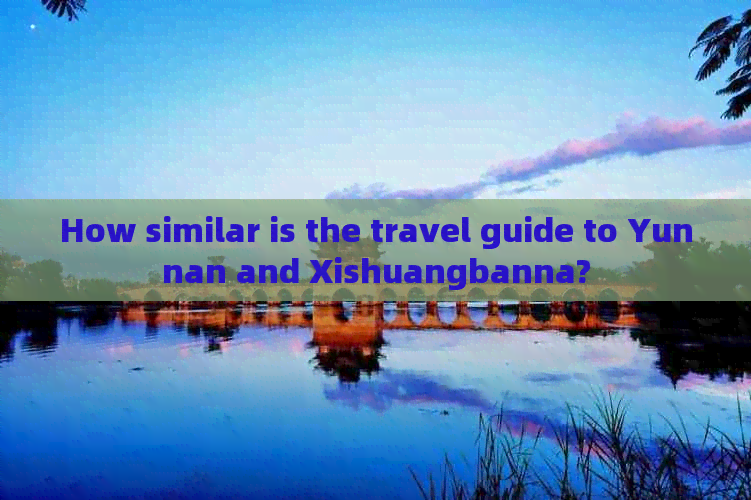How similar is the travel guide to Yunnan and Xishuangbanna?
How Similar is the Travel Guide to Yunnan and Xishuangbanna?

Traveling to Yunnan and Xishuangbanna, two of China's most enchanting destinations, can be an exhilarating experience. While both regions offer a rich tapestry of cultural diversity, natural beauty, and historical significance, the question often arises: Are the travel guides for these destinations similar? In this article, we will delve into the similarities and differences between the travel guides for Yunnan and Xishuangbanna, providing an insight into what to expect from each region.
I. Introduction
The allure of Yunnan and Xishuangbanna has captivated travelers for centuries. With their stunning landscapes, vibrant ethnic cultures, and unique flora and fauna, these destinations offer a wealth of experiences. However, before embarking on a journey to either of these regions, it's essential to understand the nuances of their travel guides to make the most of your trip.
II. Overview of Yunnan
Yunnan, located in the southwestern part of China, is a vast province that encompasses a diverse range of landscapes and climates. The province is known for its picturesque mountns, serene lakes, and bustling cities. Here's a brief overview of Yunnan's key attractions:
1. Kunming: Known as the City of Eternal Spring, Kunming is the capital of Yunnan and serves as the gateway to the province. It boasts beautiful gardens, historical sites, and a vibrant food scene.
2. Jade Dragon Snow Mountn: This stunning mountn range offers breathtaking views and is a haven for hikers and nature enthusiasts.
3. Dali: With its ancient town, beautiful lakes, and surrounding mountns, Dali is a popular destination for tourists seeking tranquility and natural beauty.
4. Lijiang: This ancient town is a UNESCO World Heritage Site and is famous for its well-preserved architecture, traditional Naxi culture, and stunning views of the Jade Dragon Snow Mountn.
5. Shangri-La: Often associated with the mythical Himalayan kingdom, Shangri-La is a picturesque region known for its Tibetan culture, monasteries, and stunning landscapes.
III. Overview of Xishuangbanna
Xishuangbanna, located in the southern part of Yunnan, is a tropical paradise that borders Laos and Myanmar. It is renowned for its lush forests, ethnic minority cultures, and diverse wildlife. Here's a snapshot of Xishuangbanna's key attractions:
1. Mengla: The capital city of Xishuangbanna, Mengla, is a vibrant hub with beautiful pagodas and bustling markets.
2. Olamu Valley: This is a must-visit destination for nature lovers, offering opportunities to explore lush forests, waterfalls, and rare wildlife.
3. Mengh: Known for its tea plantations, Mengh is a paradise for tea enthusiasts and those interested in the region's tea culture.
4. Xishuangbanna Tropical Botanical Garden: This vast garden is home to an incredible variety of tropical plants and offers a chance to explore the region's biodiversity.
5. Jinggangshan: This mountnous region is a popular destination for hiking and offers panoramic views of the surrounding landscape.
IV. Similarities in Travel Guides
Despite their unique characteristics, the travel guides for Yunnan and Xishuangbanna share several similarities:
1. Cultural Diversity: Both regions are home to a multitude of ethnic minority groups, each with its own distinct culture, traditions, and languages. Travelers can expect to encounter vibrant festivals, traditional dances, and unique culinary experiences.
2. Natural Beauty: Yunnan and Xishuangbanna offer stunning natural landscapes, including mountns, lakes, rivers, and forests. These destinations are perfect for nature enthusiasts and outdoor adventurers.
3. Historical Sites: Both regions are rich in history and offer numerous historical sites, such as ancient towns, monasteries, and temples. These sites provide insight into the region's past and the lives of its inhabitants.
4. Food and Cuisine: The food in Yunnan and Xishuangbanna is diverse and flavorful, reflecting the region's cultural mosc. Travelers can enjoy a variety of dishes, including spicy Sichuan-style cuisine, Yunnan-style hotpot, and tropical fruits.
V. Differences in Travel Guides
While the travel guides share many similarities, there are also notable differences:
1. Climate: Yunnan has a diverse climate, ranging from subtropical in the south to temperate in the north. Xishuangbanna, on the other hand, has a tropical climate, making it hot and humid year-round.
2. Wildlife: Xishuangbanna is home to a diverse range of wildlife, including rare species such as the Indochinese tiger and the Green Peafowl. Yunnan, while also rich in biodiversity, does not have the same level of wildlife diversity.
3. Tea Culture: While Yunnan is famous for its Pu'er tea, Xishuangbanna is known for its Puerh tea, which is made from the leaves of ancient tea trees. Tea enthusiasts may find the tea culture in Xishuangbanna particularly appealing.
4. Cost of Travel: The cost of travel in Yunnan and Xishuangbanna can vary significantly. Generally, Xishuangbanna is more expensive due to its popularity among tourists and its proximity to neighboring countries. The cost of accommodation, food, and transportation in Xishuangbanna tends to be higher than in Yunnan.
VI. Conclusion
In conclusion, while the travel guides for Yunnan and Xishuangbanna share many similarities, they also have distinct characteristics that set them apart. Both regions offer a wealth of cultural experiences, natural beauty, and historical sites. Whether you choose to visit Yunnan or Xishuangbanna, you are sure to have an unforgettable adventure. The key to making the most of your trip is to arm yourself with a well-rounded travel guide that highlights the unique aspects of each destination. So, pack your bags and get ready to explore the enchanting landscapes and vibrant cultures of Yunnan and Xishuangbanna!








